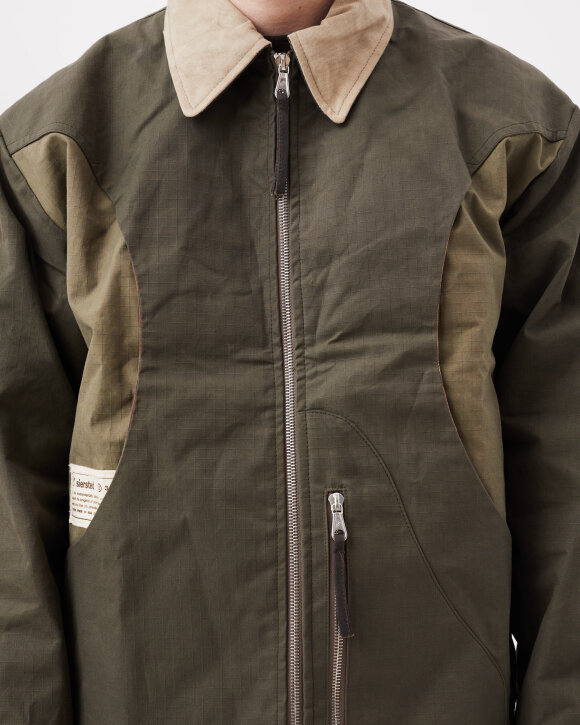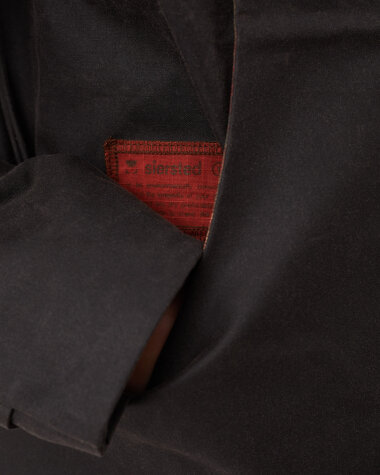-
5 QUESTIONS
DAVID SIERSTED
-
Siersted, originally a multi-brand store in Copenhagen, has transformed into a dedicated atelier focused on crafting timeless, sustainable garments. Inspired by the evocative aesthetics of artists like Todd Hido and David Carson, David Siersted creates unique pieces that celebrate raw imperfections and the natural aging process of materials. Using organic, recycled, and deadstock fabrics, the brand emphasizes quality and durability, ensuring each garment tells a story over time.
Committed to ethical craftsmanship, Siersted values the beauty found in irregularities and the personal touch in every piece. Their meticulous manual processes in dyeing and printing highlight this dedication, creating garments imbued with depth and personality. Siersted's approach rethinks industry norms, focusing on creating valuable, enduring items that resonate with their owners much like cherished pieces of art or interior design.
David Siersted, the brand's founder and creative director, sits down with Norse Store to discuss inspiration, craftsmanship, and his vision for the future of the brand after the launch of its first collection.
-
The genesis of Siersted is undoubtedly a story of passion and vision. Can you recount the journey that led to the creation of the brand and the main cultural or artistic influences that have shaped its direction and ethos?
Some might remember that Siersted used to be a multi-brand store located in Copenhagen. Working with brands from all over the world, visiting fairs, showrooms, and shows, we truly saw the nature of the industry.
The pace of production was outrageous and still is. Everything revolved around news value, and we participated in this frenzy.
At that time, I had no idea what the production world entailed or even how to use a sewing machine. Creating a universe around these established designers was what I loved most about having a store. The art direction that went into launches and installations kept the project interesting.
Day-to-day operations often interfered with these creative outlets. After three years, we decided to close the shop. Instead, we opened a small atelier and dedicated our time to learning the craft and considering how production could be improved.
Time became the essence of our brand.
To make clothes that people would buy and keep for many years, we wanted to put more thought and consideration into their creation.
-
Your first collection, "Someplace, Somewhere", encapsulates a theme of navigating through transition and the unknown. How did these themes influence the collection's aesthetics?
So, we found ourselves an atelier. Nothing special; it was located in one of those industrial suburban areas outside of Copenhagen. Most of the time, it was foggy. If you've ever seen a Todd Hido photograph, that's what it looked like.
To us, this is where it all began.
Starting from scratch in unknown territory, there was this haze of uncertainty that we wanted to portray in our collection.
We collected ripped packaging and browsed through old RayGun magazines. The graphic work by David Carson inspired us to portray usage and time as something more elevated, finding beauty in raw imperfections. Visually, when something is too controlled, too perfect, it becomes boring. To me, the irregularities of nature create the most stunning pictures.
We wanted to make more personal garments, leaving marks from the production phase in the final products. That's why we print and dye everything by hand. This way, all objects vary ever so slightly, creating depth and signs of an actual person making the garment.
Our graphic work references Carson's, created using old shipment invoices and hand-done Letraset letters—the same technique used to create those magazine covers in the 90s. Even our labels and shipping bags are made in-house to be more personal, most being burned or slightly distressed during the fixation of the print.
-
Siersted places a strong emphasis on sustainability, using natural and deadstock fabrics. Could you elaborate on the challenges and rewards of this approach, particularly in maintaining quality and durability?
To create long-lasting items, fabric choices are important to us. As we try to abstain from seasonal trends, cotton is a timeless choice. To ensure the durability and longevity of our garments, we use organic, recycled, or deadstock fabric. One of cotton's greatest qualities is how it ages.
To me, some of the most beautiful garments are those that have survived decades. It shows. You see the history in the garment. This applies to furniture, ceramics, architecture, and many other things as well. Ceramics especially inspire me. The way colors blend, depth is created, and the process of making the object shows in the outcome.
Being aware of materials and understanding the aging process help us ensure that we create objects that don't only look good at the moment of purchase.
-
Your production partnerships in Europe and the manual process of fabric dyeing and printing in Copenhagen highlight a commitment to craftsmanship and ethical practices. How do these approaches align with Siersted's brand values and what impact do they have on your collections?
When we started this, it was important for us to find our own pace and rethink some of the industry's structures.
I've always been inspired by the artisans of Asia and their handheld approach to craftsmanship, particularly textile prints and dyeing techniques done by hand.
In our part of the world, everything needs to be done quickly, efficiently, and without signs of human touch. This just doesn't align with my perception of beauty. That's why we do it this way. If the color bleeds a bit or every object is slightly different, that's okay. It's about giving personality.
Additionally, it gives us a unique opportunity to control colors, depths, and nuances. It's time-consuming, of course, but creating your own color library of uniquely crafted colors is truly satisfying.
-
Looking ahead, what new directions or themes are you exploring for Siersted's future collections?
For our future work, we will take a step back and evaluate again, still doing things at our own pace.
For upcoming collections, I think people can expect something more artistically challenging. We will stay true to our crafty approach but work even more on colors, surfaces, silhouettes, and personal expression.
Today, we talk a lot about sustainability, our commitment, and responsibility. And that's great. But in my world, sustainable efforts or practices cannot define a brand. We want to be judged for our artistic output. We aim to create garments that people value as they do interior pieces or art—objects you buy to keep for many years.






